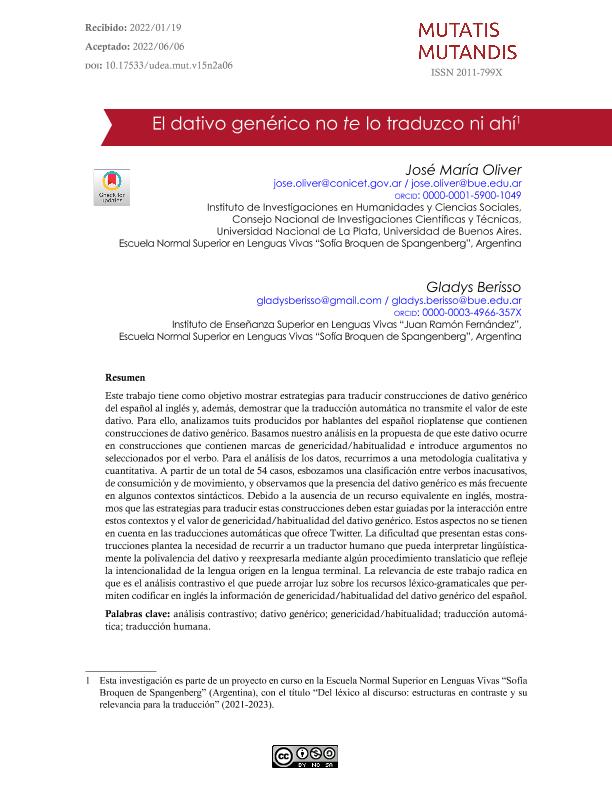Artículo
Este trabajo tiene como objetivo mostrar estrategias para traducir construcciones de dativo genérico del español al inglés y, además, demostrar que la traducción automática no transmite el valor de este dativo. Para ello, analizamos tuits producidos por hablantes del español rioplatense que contienen construcciones de dativo genérico. Basamos nuestro análisis en la propuesta de que este dativo ocurre en construcciones que contienen marcas de genericidad/habitualidad e introduce argumentos no seleccionados por el verbo. Para el análisis de los datos, recurrimos a una metodología cualitativa y cuantitativa. A partir de un total de 54 casos, esbozamos una clasificación entre verbos inacusativos, de consumición y de movimiento, y observamos que la presencia del dativo genérico es más frecuente en algunos contextos sintácticos. Debido a la ausencia de un recurso equivalente en inglés, mostra- mos que las estrategias para traducir estas construcciones deben estar guiadas por la interacción entre estos contextos y el valor de genericidad/habitualidad del dativo genérico. Estos aspectos no se tienen en cuenta en las traducciones automáticas que ofrece Twitter. La dificultad que presentan estas cons- trucciones plantea la necesidad de recurrir a un traductor humano que pueda interpretar lingüística- mente la polivalencia del dativo y reexpresarla mediante algún procedimiento translaticio que refleje la intencionalidad de la lengua origen en la lengua terminal. La relevancia de este trabajo radica en que es el análisis contrastivo el que puede arrojar luz sobre los recursos léxico-gramaticales que per- miten codificar en inglés la información de genericidad/habitualidad del dativo genérico del español. This paper aims to show strategies for translating generic dative constructions from Spanish into English, and to demonstrate that machine translation (mt) does not convey the meaning of the generic dative in Spanish. For this purpose, we have analyzed tweets produced by Rioplatense Spanish speakers. We have based our analysis on the proposal that this type of dative occurs in constructions that contain genericity/habituality markers and introduces arguments not selected by the verb. A qualitative and quantitative methodology was used to analyze these data. Based on a total of 54 cases, we outlined a classification of unaccusative, consumption and motion verbs, and we have noted that the generic dative mostly occurs in certain syntactic contexts. However, due to the fact that there is no one-to-one correspondence, i. e., no equivalent counterpart in English, we intended to demonstrate that translation strategies should be guided by an interaction between these contexts and the generic- ity/habituality value of the generic dative. These aspects are not taken into account in the machine translations provided by Twitter. That is why there is a need to resort to a human translator who can linguistically interpret the shades of meaning of this generic dative construction and re-express it by some translation procedure that reflects the intentionality of the source language (sl) in the target language (tl). The relevance of this work lies in the fact that contrastive analysis can shed light on the lexico-grammatical resources that encode the genericity/habituality information of the Spanish generic dative in English.
El dativo genérico no te lo traduzco ni ahí
Título:
Not Even Close to Translating the Generic Dative
Fecha de publicación:
07/2022
Editorial:
Universidad de Antioquia
Revista:
Mutatis Mutandis
ISSN:
2011-799X
Idioma:
Español
Tipo de recurso:
Artículo publicado
Clasificación temática:
Resumen
Palabras clave:
ANÁLISIS CONTRASTIVO
,
DATIVO GENÉRICO
,
GENERICIDAD/HABITUALIDAD
,
TRADUCCIÓN
Archivos asociados
Licencia
Identificadores
Colecciones
Articulos(IDIHCS)
Articulos de INST.DE INVEST.EN HUMANIDADES Y CS SOCIALES
Articulos de INST.DE INVEST.EN HUMANIDADES Y CS SOCIALES
Citación
Oliver, José María; Berisso, Gladys; El dativo genérico no te lo traduzco ni ahí; Universidad de Antioquia; Mutatis Mutandis; 15; 2; 7-2022; 367-384
Compartir
Altmétricas




